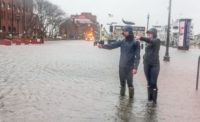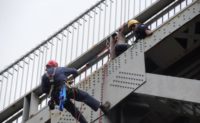Report Calls for Regional Clean Transportation Plan
Natural Resources Defense Council report focuses on the Northeast and Mid-Atlantic regions

Creating more walkable and bike-friendly streets, expanding electric vehicle fleets and reducing congestion and increasing access to public transportation in cities, suburbs and rural and low-income communities across the Northeast and Mid-Atlantic regions are among the strategies outlined in a new report calling for a regional clean transportation plan.
Unveiled on July 19, the Natural Resources Defense Council’s report entitled Transportation Reimagined, says the nation’s current transportation system cost the economy $147 billion in 2015 alone. A nonprofit environmental organization, NRDC also says transportation is the largest source of greenhouse gas emissions in the nation and that improvements to the nation’s transportation sector could provide nearly a third of the emissions reductions needed to cut U.S. greenhouse gas by 80% by mid-century. “We cannot solve climate change unless we address this sector,” says Bruce Ho, the report's principal author and a senior advocate at NRDC.
The report focuses on modernizing transportation in 11 states (Connecticut, Delaware, Maine, Maryland, Massachusetts, New Hampshire, New Jersey, New York, Pennsylvania, Rhode Island, Vermont) and Washington, D.C. Last fall, seven of these states and Washington D.C. agreed to develop a roadmap for making the East Coast’s transportation systems more interconnected and environmentally friendly. The states have held several listening sessions across the region, with the next one scheduled for July 24 in New York City.
A broader coalition forged by all 11 of these states is called the Transportation and Climate Initiative. These states also collaborated about a decade ago to reduce greenhouse gas emissions from the region’s power plants by half. “NRDC’s report offers solutions that could guide the regional collaboration,” NRDC noted in a press release announcing the report.
The report doesn’t just suggest improving links between pedestrian and bike paths to transit corridors in the region’s urban cores, it also suggests better linking those urban areas with suburban and rural areas. This could be done by improving rapid transit connections between rural areas and cities. “This report envisions a cleaner, more equitable, and more accessible transportation system for the region,” the report says.
NRDC says the suggested strategies in the report are based on tactics that have already been successfully piloted around the country. For example, the report lauds efforts in Washington D.C. and Cambridge, Mass. to implement better bicycle infrastructure such as protected bike lanes, bike parking and bike-sharing programs.
The report also highlighted an effort in Arlington County, Va. to widen sidewalks and provide pedestrians with median islands, and sidewalk extensions that shorten the distance needed to walk to cross the road. In 2009, Arlington County also became the first county in the nation to install automated sensors that count pedestrian and bike traffic on trails and bike paths. “These sensors help decision makers understand how people use biking and walking infrastructure so they can identify areas and priorities for improvement,” the report says.
One suggestion for the Boston area that is highlighted in the report is to reduce dwell times at train stations by raising platforms. Boston-based nonprofit TransitMatters says "step-free, level boarding of commuter trains" could cut travel times by 40%. TransitMatters also recommends switching to all-electric trains to reduce emissions.
But modernizing America's transportation system will not be cheap. The American Society of Civil Engineers estimates that fixing the nation's infrastructure would cost $1.2 trillion during the next decade. Ho says the upfront investment to implement the suggestions in NRDC's report could be paid for with a hard cap on transportation pollution that requires a "significant reduction in that pollution over time" and could "include market-based mechanisms that deliver revenue for clean transportation and pollution reduction."
Ho says similar mechanisms have worked in the Northeast's power sector and in California's transportation system. "This type of policy would certainly be one way of getting to where we need to go but we are also open to others and that's an important part of the current regional discussions that are going on [and are] led by states in this region."





